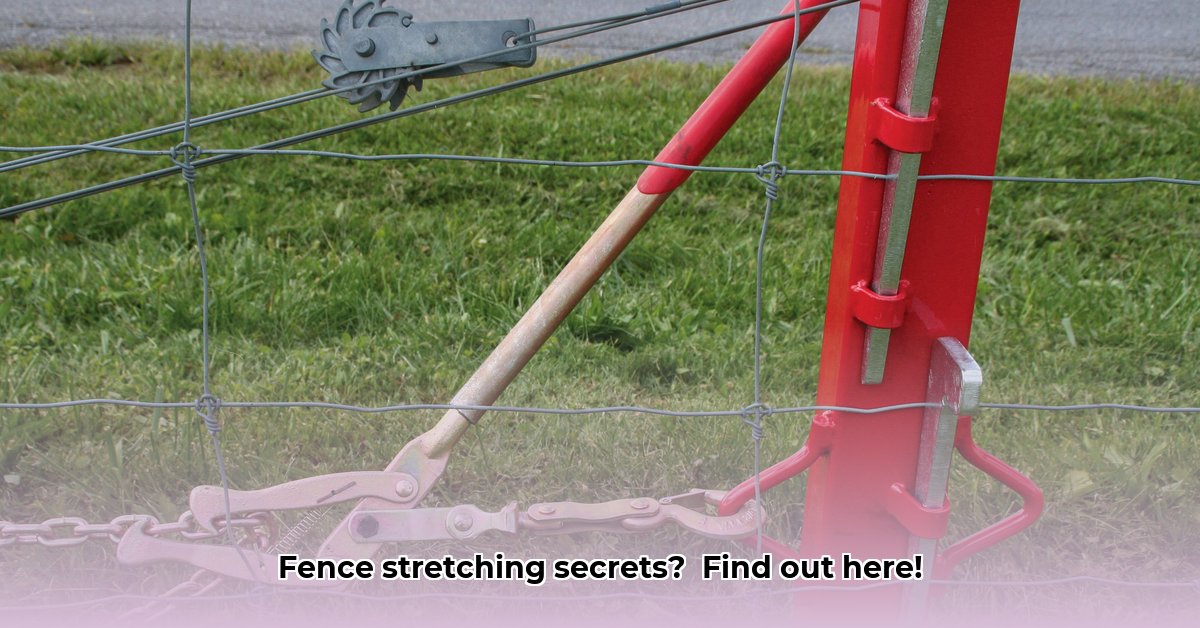
Fence Stretchers: Revolutionizing Sustainable Fencing Practices
Effective fencing is paramount for efficient and sustainable farming. It protects livestock, secures crops, and facilitates rotational grazing—a cornerstone of regenerative agriculture. However, traditional fencing methods often fall short in terms of longevity and environmental impact. Wooden posts rot, metal corrodes, and the constant need for repairs leads to waste and increased labor costs. This is where the humble fence stretcher, particularly those available from Tractor Supply, steps in as a game-changer. Find more information on fence stretchers at Tractor Supply. This guide provides a practical, step-by-step approach to building and maintaining sustainable fences using a fence stretcher, maximizing efficiency while minimizing environmental impact.
Sustainable Fencing Materials: A Greener Approach
Traditional fencing materials like wood and barbed wire present significant drawbacks. Wood deteriorates, requiring frequent replacement, while metal rusts and contributes to environmental pollution. Fortunately, sustainable alternatives are increasingly available.
Eco-Friendly Options:
Recycled Materials: Utilize recycled plastic or metal fencing. These options boast extended lifespans compared to conventional materials while reducing landfill waste. This is a highly effective method for reducing your farm's environmental footprint.
Bio-based Materials: Explore fencing constructed from rapidly renewable resources such as bamboo. These bio-based options offer a truly sustainable solution, minimizing carbon emissions associated with material production and transportation. Availability and cost may vary regionally.
Electric Fencing: Ideal for rotational grazing, electric fencing necessitates significantly less material than conventional methods, making it a more sustainable choice. Its flexibility also allows for easy adjustments and relocation as needed. However, proper installation and maintenance are crucial for both safety and effectiveness.
The Fence Stretcher: Efficiency Redefined
A fence stretcher, readily available at Tractor Supply, isn't simply a tool; it's an investment in efficiency and sustainability. It dramatically simplifies the process of stretching wire, eliminating tiresome manual labor and ensuring consistent tension.
Key Advantages of Using a Fence Stretcher:
Enhanced Speed and Efficiency: Quickly and easily tighten wire, eliminating sags and uneven tension. This translates to significant time savings, allowing you to focus on other crucial farm tasks.
Extended Fence Lifespan: Proper tensioning prevents wear and tear, considerably extending the lifespan of your fencing materials. This reduces replacement costs and minimizes waste.
Reduced Labor Costs: The fence stretcher significantly reduces the manual labor required, leading to both cost and time savings. This can also decrease the need for additional labor.
Step-by-Step Guide to Sustainable Fence Installation
Before starting, gather necessary materials: posts (prioritize durable, sustainable options), wire, staples, and your Tractor Supply fence stretcher.
1. Strategic Planning: Meticulously plan your fence’s route, considering terrain, existing structures, and optimal post placement. This upfront planning minimizes future complications.
2. Precise Post Placement: Set posts at evenly spaced intervals, appropriate for your chosen wire and terrain. Ensure firm anchoring for stability.
3. Secure Wire Attachment: Fasten one wire end to a robust post. This serves as your starting point.
4. Efficient Wire Tensioning: Attach the wire to the fence stretcher, adhering to manufacturer instructions. Gradually increase tension until the wire is taut but not overstretched (over-stretching weakens the wire).
5. Secure Wire Fixation: Attach the taut wire to the remaining posts using staples or clips. Maintain consistent tension along the entire fence length.
6. Thorough Inspection: Inspect the entire fence for sagging or loose sections. Make necessary adjustments to ensure strength, evenness, and safety.
Selecting the Right Fence Stretcher at Tractor Supply
Tractor Supply offers a range of fence stretchers. The optimal choice depends on individual needs. Consider these factors:
| Feature | Considerations |
|---|---|
| Tension Capacity | Match wire type and gauge. Higher capacity suits heavier-duty wire. |
| Ease of Use | Hand cranks versus hydraulic assist – choose based on your strength and experience. |
| Durability | Prioritize robust designs and high-quality materials for longevity. |
| Price | Balance cost against long-term functionality; a more expensive model might prove more cost-effective over time. |
| Weight | Lighter models offer enhanced maneuverability. |
Choosing Cost-Effective Sustainable Fencing Materials for Rotational Grazing
Effective rotational grazing hinges on reliable fencing. The right fencing material balances durability, cost-effectiveness, and environmental impact.
Material Considerations:
Wood: Traditional and visually appealing, but requires maintenance and is susceptible to rot.
PVC: More durable than wood, resistant to rot, but may not be as strong and its sustainability depends on recycling.
Wire: Relatively inexpensive and readily available, but prone to corrosion and breaks.
Recycled Materials: Opt for recycled options to minimize waste and promote sustainability.
Electric Fencing Integration: Electric fencing significantly improves rotational grazing. However, proper livestock training and careful installation are essential.
Step-by-Step Material Selection:
Needs Assessment: Animal type, terrain, land area, and budget influence material selection.
Budget Allocation: Determine your initial investment capacity and ongoing maintenance costs.
Material Choice: Select materials aligning with needs and budget, considering lifecycle costs over initial outlay.
Installation Expertise: Seek professional assistance if needed, especially for electric fencing.
Maintenance Schedule: Establish a regular inspection and repair schedule to extend fence lifespan.
Regular maintenance prolongs fence life and optimizes farm efficiency. Combining sustainable materials with efficient tools like a fence stretcher from Tractor Supply enables the creation of a resilient and environmentally friendly fencing system.